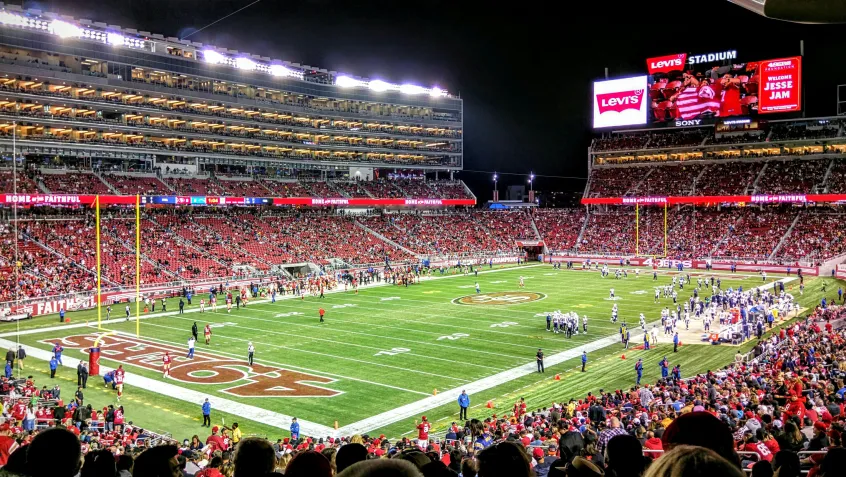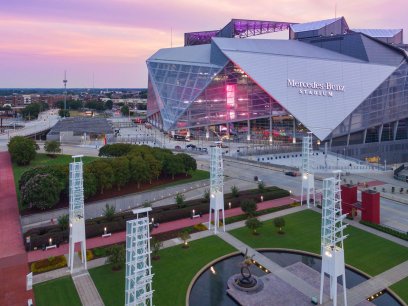
Team jersey? Check. Chips and dip? Check. Eleven hundred and sixty-two solar panels, a 27,000 square-foot green roof, and an extensive plumbing network that draws recycled water for 85% of your water needs? If you're watching a game from the stands of Levi's Stadium, that's another check.
In 2016, Super Bowl 50 was held in Santa Clara, California, in the Levi's Stadium, the first sports stadium in the United States to open with a LEED Gold status from the US Green Building Council (USGBC). This certification is given to buildings that earn a sufficiently high score in the USGBC's credit categories, which focus on resource-efficiency, sustainability, and cost-effectiveness in design.
Not watching a game from Levi's Stadium? Don't worry, you can put your own spin on some of the stadium's amenities to make for a more authentic viewing experience at home.
- Energy efficiency: Levi's Stadium is outfitted with 1,162 solar panels, which are designed to annually generate more electricity than is consumed during a 10-home-game season for the San Francisco 49ers.
- What you can do: Minimize your energy use by lighting your home with energy-efficient, ENERGY STAR certified light bulbs. These bulbs use 70-90% less energy than traditional incandescent bulbs, and they last 10-25 times longer. If you're looking to replace a larger appliance, check out the ENERGY STAR site to find the most energy-efficient models of dishwashers, clothes washers, refrigerators, and more.
- What you can do: Minimize your energy use by lighting your home with energy-efficient, ENERGY STAR certified light bulbs. These bulbs use 70-90% less energy than traditional incandescent bulbs, and they last 10-25 times longer. If you're looking to replace a larger appliance, check out the ENERGY STAR site to find the most energy-efficient models of dishwashers, clothes washers, refrigerators, and more.
- Water conservation: The stadium is equipped with low-flow fixtures including toilets, urinals, and sinks, which use 40% less water than their conventional counterparts. In addition to these indoor low-flow plumbing choices, the traditional hoses used to clean the seating areas, which use 16,000 gallons of water per hour at the stadium, were phased out in favor of using a pressure-washer system, which uses less than a fourth the amount of water at 3,000 gallons per hour.
- What you can do: There are many low-flow fixtures available for residential use, including showerheads, toilets, sinks, and lawn sprinkler systems. Low-flow fixtures that have earned the EPA WaterSense label are third-party independently certified to be 20% more water-efficient than standard models, while performing as well as or better than their traditional counterparts. For instance, swapping out old showerheads for WaterSense labeled models can save the average family up to 2,900 gallons of water per year. Many states even offer rebates for purchasing these water-efficient fixtures. Check out the EPA WaterSense site to learn more.
- What you can do: There are many low-flow fixtures available for residential use, including showerheads, toilets, sinks, and lawn sprinkler systems. Low-flow fixtures that have earned the EPA WaterSense label are third-party independently certified to be 20% more water-efficient than standard models, while performing as well as or better than their traditional counterparts. For instance, swapping out old showerheads for WaterSense labeled models can save the average family up to 2,900 gallons of water per year. Many states even offer rebates for purchasing these water-efficient fixtures. Check out the EPA WaterSense site to learn more.
- Water recycling: About 85% of the water that Levi's Stadium does use is recycled water provided by the Santa Clara Valley Water District. “Recycled water” is wastewater (water that goes down the drain in homes, businesses, and industrial settings) that the water authority treats with multiple methods to produce highly purified water. At Levi's Stadium, this recycled water is used for playing field irrigation, watering the stadium's green roof, refrigeration, cooling the stadium, and flushing toilets.
- What you can do: Look for opportunities to recycle water around your home! If you're going to replace the water in your pet's watering dish, you can use the old water to hydrate your plants instead of throwing it down the drain. If your car needs a wash, look for a local car wash that recycles the water rather than hosing it off yourself. This has the added benefit of helping to keep your car wash detergent out of local waterways.
- What you can do: Look for opportunities to recycle water around your home! If you're going to replace the water in your pet's watering dish, you can use the old water to hydrate your plants instead of throwing it down the drain. If your car needs a wash, look for a local car wash that recycles the water rather than hosing it off yourself. This has the added benefit of helping to keep your car wash detergent out of local waterways.
- Smart landscaping: While it may not be landscaping in the traditional sense of the word, Levi's Stadium uses a garden of 16 native plant species to its maximum advantage—on the roof! This 27,000 square-foot green roof sits on top of the stadium's SAP Tower, which contains the majority of the stadium's suites. This living roof houses drought-resistant succulent species that form a barrier to heat transfer between the stadium and the surrounding air, reducing the need for cooling in the stadium while at the same time adding insulation to the building, reducing the need for heating indoors.
- What you can do: If installing a green roof of your own isn't in the cards, consider other smart landscaping choices. Look for native plants suited for your local climate when choosing updates for your lawn or garden—these species require minimal irrigation beyond normal rainfall for your area, reducing your water use.
The final step to making your game-day party as authentic as possible: tell your guests about your improvements! Levi's Stadium has a live dashboard that displays the stadium's current energy measurements, water and air monitors, and other dynamic green features as the building operates, allowing visitors to see the results of the stadium's sustainability efforts. You can do the same by sharing your progress with your friends, and letting them know how you like your enhanced home “stadium.”
Sources:
- California Native Plant Society. 2016. “Benefits of Native Plants.” Accessed February 1. http://www.cnps.org/cnps/grownative/benefits.php
- ENERGY STAR. 2016. “Energy Efficient Products.” Accessed February 1. https://www.energystar.gov/products?s=mega
- ENERGY STAR. 2016. “Light Bulbs for Consumers.” Accessed February 1. http://www.energystar.gov/products/lighting_fans/light_bulbs
- Goldberg, Bruce. 2015. “Green Thumbs: On-site gardens continue to take root as sports facilities tout sustainability efforts and cater to fan desires.” Street & Smith's SportsBusiness Journal. June 29-July 5, 2015. Accessed February 1, 2016. http://greensportsalliance.org/wp-content/uploads/2015/07/SBJ_Sports-Sustainability-In-Depth_6.29.15.pdf
- Green Sports Alliance. 2014. “49ers' Levi's Stadium in Pursuit of Becoming Nation's Greenest Stadium with Recycled Water Use.” Accessed February 1, 2016. http://greensportsalliance.org/49ers-levis-stadium-in-pursuit-of-becoming-nations-greenest-stadium-with-recycled-water-use/
- HUD. 2011. “CMHA Installs Green Roofs on Low-Rise Buildings” EcoWise. June 2011. Accessed February 1, 2016. http://portal.hud.gov/hudportal/documents/huddoc?id=phecc_newslttrjune.pdf
- Illinois Environmental Protection Agency. 2015. “How Do I Handle My Professional Car Wash Wastewater?” Accessed February 1, 2016. http://www.epa.illinois.gov/topics/small-business/publications/car-wash/
- Levi's Stadium. 2013. “Bay Area Host to Super Bowl.” Accessed February 1, 2016. http://www.levisstadium.com/2013/05/bay-area-host-super-bowl-l/
- Levi's Stadium. 2016. “Stadium Info.” Accessed February 1, 2016. http://www.levisstadium.com/stadium-info/about-levis-stadium/
- Levi's Stadium. 2014. “Stadium Sets New Standard for the Use of Recycled Water.” Accessed February 1, 2016. http://www.levisstadium.com/2014/06/stadium-sets-new-standard-use-recycled-water/
- San Francisco 49ers. 2015. “Levi's Stadium Media Guide.” Accessed February 1, 2016. http://49ers.1stroundmediagroup.com/levisstadium/
- Santa Clara Valley Water District. 2015. “Recycled Water.” Accessed February 1. http://www.valleywater.org/Services/RecycledWater.aspx
- US EPA. 2016. “WaterSense Showerheads.” Accessed February 1. http://www3.epa.gov/watersense/products/showerheads.html
- US EPA. 2015. “Water Recycling and Reuse: The Environmental Benefits.” http://www3.epa.gov/region9/water/recycling/
- US EPA. 2016. “WaterSense Statistics & Facts.” Accessed February 1. http://www3.epa.gov/watersense/about_us/facts.html
- US Green Building Council. 2016. “This is LEED.” Accessed February 1. http://leed.usgbc.org/leed.html


